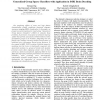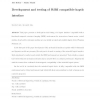119
Voted
JOCN
2011
14 years 3 months ago
2011
■ Previous studies suggested that the observation of other individualsʼ somatosensory experiences also activates brain circuits processing oneʼs own somatosensory experiences....
105
click to vote
ICASSP
2011
IEEE
14 years 4 months ago
2011
IEEE
Functional magnetic resonance imaging (fMRI) is a popular tool for studying brain activity due to its non-invasiveness. Conventionally an expected response needs to be available f...
117
click to vote
ICASSP
2011
IEEE
14 years 4 months ago
2011
IEEE
Real-time functional magnetic resonance imaging (rtfMRI) enables classification of brain activity during data collection thus making inference results accessible to both the subj...
121
Voted
CVPR
2011
IEEE
14 years 4 months ago
2011
IEEE
The perplexing effects of noise and high feature dimensionality greatly complicate functional magnetic resonance imaging (fMRI) classification. In this paper, we present a novel f...
116
Voted
TMI
2010
14 years 7 months ago
2010
Classification of brain images obtained through functional magnetic resonance imaging (fMRI) poses a serious challenge to pattern recognition and machine learning due to the extrem...
138
Voted
ICONFERENCE
2011
14 years 7 months ago
2011
The author proposed three studies (i.e. a large-N survey, a behavioral experiment, and a functional magnetic resonance imaging research) to investigate whether people read icons a...
ROBOTICA
2010
14 years 11 months ago
2010
This paper presents a development and testing of a haptic interface compatible with a functional magnetic resonance imaging (fMRI) environment for neuroscience human motor control ...
129
Voted
MICCAI
2010
Springer
14 years 11 months ago
2010
Springer
Due to the complex noise structure of functional magnetic resonance imaging (fMRI) data, methods that rely on information within a single subject often results in unsatisfactory fu...
84
Voted
IJON
2002
15 years 11 days ago
2002
Since the functional magnetic resonance imaging (fMRI) signal is likely to re ect a spatial average of the activity of neurons with partly dissimilar response properties, its inte...
106
click to vote
TMI
2008
15 years 17 days ago
2008
We propose a new method for detecting activation in functional magnetic resonance imaging (fMRI) data. We project the fMRI time series on a low-dimensional subspace spanned by wave...




